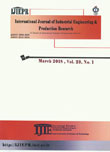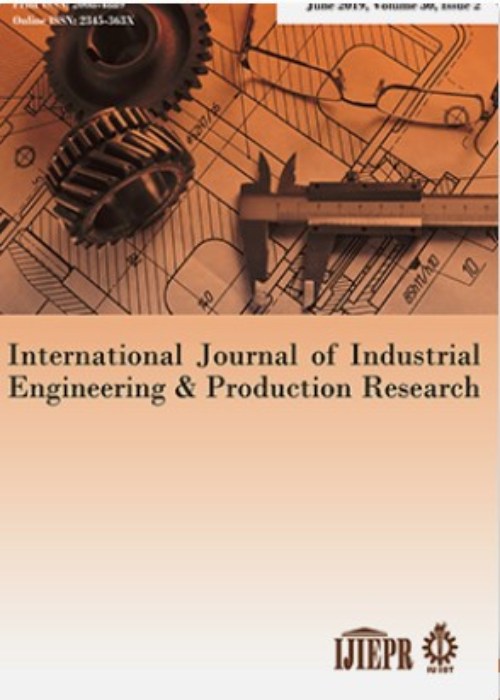فهرست مطالب

International Journal of Industrial Engineering and Productional Research
Volume:29 Issue: 2, Jun 2018
- تاریخ انتشار: 1397/03/09
- تعداد عناوین: 8
-
-
Page 117Surgical theater is one of the most expensive hospital sources that a high percentage of hospital admissions are related to it. Therefore, efficient planning and scheduling of the operating rooms (ORs) is necessary to improve the efficiency of any healthcare system. Therefore, in this paper, the weekly OR planning and scheduling problem is addressed to minimize the waiting time of elective patients, overutilization and underutilization costs of ORs and the total completion time of surgeries. We take into account the available hours of ORs and the surgeons, legal constraints and job qualification of surgeons, and priority of patients in the model. A real-life example is provided to demonstrate the effectiveness and applicability of the model and is solved using ε-constraint method in GAMS software. Then, data envelopment analysis (DEA) is employed to obtain the best solution among the Pareto solutions obtained by ε-constraint method. Finally, the best Pareto solution is compared to the schedule used in the hospitals. The results indicate the best Pareto solution outperforms the schedule offered by the OR director.Keywords: Multi objective model, OR planning, scheduling, ?, constraint method, Data envelopment analysis
-
Page 133Innovation & Prosperity Fund (IPfund) in Iran as a governmental organization aims to develop new technology-based firms (NTBF) by its available resources through financing these firms. The innovative projects which refer to IPfund for financing are in a stage which can receive both fixed rate facilities and partnership in the projects, i.e. profit loss sharing (PLS). Since this fund must protect its initial and real value of its capital against inflation rate, therefore, this study aims to examine the suitable financing methods with considering risk. For this purpose we study on risk assessment models to see how to use risk adjusted net present value for knowledge based projects. On this basis, the NPV of a project has been analyzed by taking into account the risk variables (sales revenue and the cost of fixed investment) and using Monte Carlo simulation. The results indicate that in most cases for a project, the risk adjusted NPV in partnership scenario is more than the other scenario. In addition to, partnership in projects which demand for industrial production facilities is preferable for the IPfund than projects calling for working capital.Keywords: Risk Analysis, Risk Adjusted Net Present Value, Monte Carlo Simulation, Fixed Rate Facilities, Partnership, Investment Evaluation
-
Page 147Supplying of blood and blood products is one of the most challenging issues in the healthcare system since blood is as extremely perishable and vital good and donation of blood is a voluntary work. In this paper, we propose a two-stage stochastic selective-covering-inventory-routing (SCIR) model to supply whole blood under uncertainty. Here, set of discrete scenarios are used to display uncertainty in stochastic parameters. Both of the fixed blood center and bloodmobile facilities are considered in this study. We suppose that the number of bloodmobiles is indicated in the first stage before knowing which scenario is occurred. To verify the validation of the presented SCIR model to supply whole blood, we examine the impact of parameters variation on the model outputs and cost function using the CPLEX solver. Also the results of comparison between the stochastic approach and expected value approach are discussed.Keywords: Inventory, Routing, Covering problem, Selective Vehicle, Routing, Mobile Blood Collection
-
Page 159In this article, we propose a special case of two-echelon location-routing problem (2E-LRP) in cash-in-transit (CIT) sector. To tackle this realistic problem and to make the model applicable, a rich LRP considering several existing real-life variants and characteristics named BO-2E-PCLRPSD-TW including different objective functions, multiple echelons, multiple periods, capacitated vehicles, distribution centers and automated teller machines (ATMs), different type of vehicles in each echelon, single-depot with different time windows is presented. Since, routing plans in the CIT sector ought to be safe and efficient, we consider the minimization of total transportation risk and cost simultaneously as objective functions. Then, we formulate such complex problem in mathematical mixed integer linear programming (MMILP). To validate the presented model and the formulation and to solve the problem, the latest version of ε-constraint method namely AUGMECON2 is applied. This method is especially efficient for solving multi objective integer programing (MOIP) problems and provides the exact Pareto fronts. Results substantiate the suitability of the model and the formulation.Keywords: two, echelon location, routing problem, mixed integer linear programming, cash in transit, multiple objective optimization, augmented ?, constraint method
-
Page 175The fundamental function of a cellular manufacturing system (CMS) is based on definition and recognition of a type of similarity among parts that should be produced in a planning period. Cell formation (CF) and cell layout design are two important steps in implementation of the CMS. This paper represents a new nonlinear mathematical programming model for dynamic cell formation that employs the rectilinear distance notion to determine the layout in the continuous space. In the proposed model, machines are considered unreliable with a stochastic time between failures. The objective function calculates the costs of inter and intra-cell movements of parts and the cost due to the existence of exceptional elements (EEs), cell reconfigurations and machine breakdowns. Due to the problem complexity, the presented mathematical model is categorized in NP-hardness; thus, a genetic algorithm (GA) is used for solving this problem. Several crossover and mutation strategies are adjusted for GA and parameters are calibrated based on Taguchi experimental design method. The great efficiency of the proposed GA is then demonstrated via comparing with particle swarm optimization (PSO) and the optimum solution via GAMS considering several small/medium and large-sized problems.Keywords: Cellular manufacturing system, Cell formation, Cell layout, Machine reliability, Meta, heuristic algorithms
-
Page 197Nowadays, several methods in production management mainly focus on the different partners of supply chain management. In real world, the capacity of planes is limited. In addition, the recent decade has seen the rapid development of controlling the uncertainty in the production scheduling configurations along with proposing novel solution approaches. This paper proposes a new mathematical model via strong recent meta-heuristics planning. This study firstly develops and coordinates the integrated air transportation and production scheduling problem with time windows and due date time in Fuzzy environment to minimize the total cost. Since the problem is NP-hard, we use four meta-heuristics along with some new procedures and operators to solve the problem. The algorithms are divided into two groups: traditional and recent ones. Genetic Algorithm (GA) and Particle Swarm Optimization (PSO) as traditional algorithms, also Keshtel Algorithm (KA) and Virus Colony Search (VCS) as the recent ones are utilized in this study. In addition, by using Taguchi experimental design, the algorithm parameters are tuned. Besides, to study the behavior of the algorithms, different problem sizes are generated and the results are compared and discussed.Keywords: Integrated capacitated air transportation, production scheduling, Time window, Fuzzy consideration, Keshtel algorithm, Virus colony search
-
Page 213Reliability allocation has an essential connection to design for reliability and is an important activity in the product design and development process. In determining the reliability of subsystems or components on the basis of goal reliability, attention must be paid to failure effect, failure information, and improvement opportunities based upon real potentials for reliability improvement. In the light of the fact that ignoring dependent failures inflicts irreversible damage on systems, and that redundant systems are vulnerable to Common Cause Failure (CCF) as well as independent failure, attention must be paid not only to components independent failure information, but also to CCF information in conducting reliability allocation for such systems. To consider improved failure rate alone cannot ensure the achievement of the goal reliability in question, because if the CCF occurrence exceeds a certain limit, the systems reliability will certainly fail to match the goal reliability. This paper is an attempt to develop a method for reliability allocation of series-parallel systems by considering CCF, in such a way that potentials and priorities of reliability improvement are taken into consideration. The proposed method consists of four stages: 1) adding a series component to the redundant system in order to investigate CCF, 2) conducting reliability allocation for series components and the redundant system, 3) conducting reliability allocation for redundant system components, and 4) analyzing the failure rate of system components. The proposed method is run for water pumping systems and the results are evaluated. In this method, in addition to the improved failure rate of system components, the improved rate of CCF is computed, too. This proves instrumental and crucial for system designers in feasibility studies and conceptual design.Keywords: reliability allocation, dependent failure, common cause failure, redundant system, series, parallel system, improvement prioritization
-
Page 231The aim of this study is to present a new method to predict project time and cost under uncertainty. Assuming that what happens in projects implementation which is expressed in the form of Earned Value Management (EVM) indicators is primarily related to the nature of randomness or unreliability, in this study, by using Monte Carlo simulation, and assuming a specific distribution for the time and cost of project activities, a significant number of predicting scenarios will be simulated. According to the data, an artificial neural network is used as efficient data mining methods to estimate the project time and cost at completion.Keywords: Project Management, Earned Value Management, Estimate At Completion (EAC), Monte Carlo simulation, Artificial Neural Network


